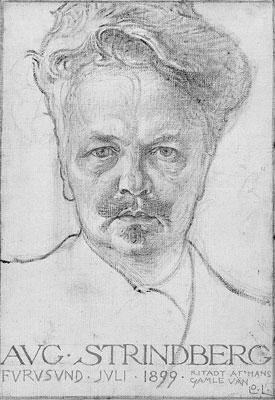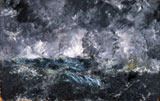Johan Christian Dahl |
Hans Fredrik Gude |
Kitty Lange Kielland
Theodor Philipsen |
Akseli Gallén-Kallela |
Eero Järnefelt
Edvard Munch |
August Strindberg |
Prince Eugen

Choose from a selected group of artists represented in the exhibition A Mirror of Nature: Nordic Landscape Painting 1840-1910.

August Strindberg
Stockholm 1849 -Stockholm 1912, Swedish
Painting was, all in all, merely a parenthesis in the career of author and playwright August Strindberg. After a tentative beginning in 1872, it was concentrated chiefly in the years 1892-94, 1901-02, 1903 and 1905. Strindberg had no formal artistic training, but developed extensive links with the world of visual art. He was well acquainted with the progressive art of his day, thanks to his close dealings with a number of contemporary Swedish and European artists, such as Richard Bergh, Ernst Josephson, Carl Larsson, Karl Nordström, Christian Krohg, Edvard Munch, Paul Gauguin and Alphonse Mucha. In the 1870s, Strindberg also worked as an art critic for the Stockholm press. In this area, he adopted a fairly conventional stance, but he also distinguished himself by his ability to understand and accurately characterize even artistic manifestations for which he felt little sympathy. One well-known example of this is his account of his first encounter with Impressionism in the showrooms of the art dealer Durand-Ruel in Paris in 1876, recorded in the article "From Café de l'Ermitage to Marly-le-Roi". Another is a letter to Paul Gauguin in which, to justify his refusal to write a foreword for his exhibition in Paris in 1895, Strindberg undertook an analysis of Gauguin's art. So apposite did Gauguin find his characterization that he had the letter printed as his foreword.
August Strindberg's painting portrays the topography of the soul, rather than of the Swedish landscape, and stands entirely apart from the other artistic currents of the turn of the century. The only similarity lies in its subjectivity, although Strindberg went further than his contemporaries, both in this regard and in terms of technical freedom. As an amateur he could afford to experiment, one manifestation of this being his extensive use of a palette knife. His artistic method was one of spontaneous association, and he allowed one idea to lead to another in a kind of dialogue with his work, which he described in his remarkable essay on art theory entitled "New directions in art! Or the role of chance in artistic creation" (1894). Strindberg also turned his attention to other fields, such as science, alchemy and photography, and here, too, he proceeded by trial and error.
An important key to understanding Strindberg's painting is its therapeutic function. Often he had recourse to painting as a creative alternative at times when he felt unable to write. It is therefore natural to see an autobiographical dimension in the troubled, dramatic moods and dark colours of his pictures.
The unique and ground-breaking character of Strindberg's painting only began to be appreciated in the 1920s - despite the fact that the first exhibition of his works was held as early as 1892, that Strindberg contributed to the Artists' Association exhibition of 1895, and that Richard Bergh included his work in the Nationalmuseum exhibition Swedish Art of the Modern Breakthrough in 1914.
|













